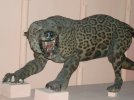l. My oryx was shot right between the eyes with a .300 win mag 168 grain Barnes TTSX Bullet from a distance of about a 100 metres. I was especially proud of the shot cause i know that in SA everybody shoots between the eyes, but we european hunters are not used to it.
Bart sorry to hear about this and i hope you get to the bottom of it, however you state that everybody shoots their animals between the eyes in SA, i would say the reason for this is they are mostly hunting for meat and use the head and neck shots so there is minimum wastage of meat. it should be the last resort when going for a trophy as you end up with the problems you have experienced.

Spike, you are correct. It is customary for locals to shoot head and neck shots during meat hunts or culls, but this is purely to save on meat damage. I will never ask anyone of my hunters to shoot a head shot. The risk of shooting the jaw off is just too high, and I can't think of anything worse for an animal. Neck shot, it would depend on the shots taken by the hunter in previous days and the results, how good the trophy is, like a 40" Eland or something along those lines, distance of the shot, and that there is no other way to get a body shot. A high neck shot, where the scull joins the neck, can be devastating, even missing the spine, an animal will drop, just from the shock.


